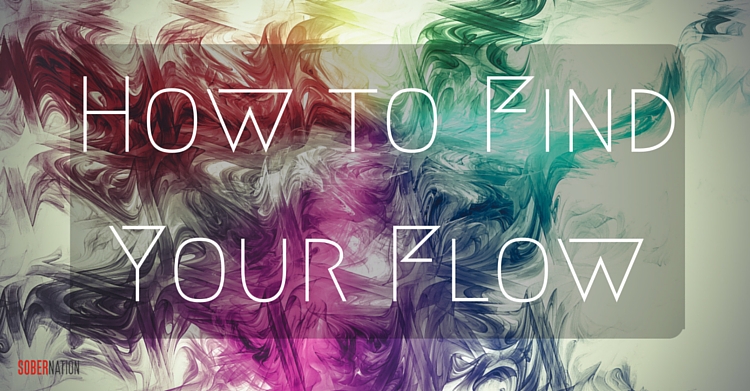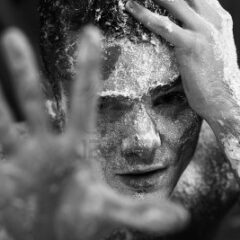May 20, 2016 | By Nadia Sheikh
Find Your “Flow” – Getting Creative in Recovery
Mental Health Personal Addiction Recovery Stories Recovery
There is so much talk about what needs to be done daily to maintain our recovery—talk to your sober supports, go to recovery meetings, help someone else in need. Recovery is also about our mental wellness and wholeness as human beings. Sometimes we need to get creative with our recovery. We can switch up our routines and try new meditation techniques, but when was the last time you actually got creative?
When we engage our minds creatively, a phenomenon occurs which psychologists are calling “flow.” This state of mind is considered an ”optimal state of consciousness” where we feel and perform our best, and we don’t just have to be drawing or painting to find our flow. Athletes call it “being in the zone.” When someone is in flow, concentration is “so laser-focused that everything else falls away,” we lose our sense of time and self. Our awareness hones in entirely on the action at hand.
In addiction, I expended so much effort trying to run away from reality and my responsibilities. I did not want to feel. Escapism was a way of life for me because I was always preoccupied with regrets from the past or fear of what came next. Finding your flow is a healthy way to lose our sense of self through immersion in an activity, to take a little break from our daily life without returning to our old behaviors.
What’s Flow Got to Do With It?
A state of flow is extremely similar to the state of our minds while meditating, which can be a crucial aspect of recovery and mindful living. Beyond this, psychologists who study flow claim it may be the secret key to happiness. The simple act of occupying ourselves with an activity, whether it be drawing, painting, knitting, or otherwise, causes the repetitive motion to activate our parasympathetic nervous system, quieting any external chaos and emotional turmoil.
Normally, our brain is in a fast-moving state of beta waves. What was I supposed to do today? What do I need to do later? What’s that guy doing over there?
In flow, our brainwaves slow to an alpha state, our day-dreaming and meditation mode, where we slip from thought to thought easily. Those waves can even slow down to near theta waves, the state during REM sleep or just before we fall asleep. This is when ideas start to combine in radical, unusual ways, which is ideal for creativity and innovative thinking.
Our prefrontal cortex is also temporarily deactivated in flow, which allows us to simply exist and create without self-consciousness or judgment. We become more courageous and see new possibilities.
There is also evidence to support the benefits of creative activities on our brains. When we do something enjoyable, our brains release dopamine, which is a natural anti-depressant that us addicts and alcoholics love. Finding more ways to naturally stimulate dopamine production, rather than seeking it in alcohol and drugs, is key to sustaining recovery.
Studies have found that the majority of subjects engaged in a crafty activity like knitting report a feeling of calmness and happiness afterwards. These test subjects also showed evidence of higher cognitive functioning as a result of their habitual crafting. Feel good and metaphorical brain-jumping-jacks? I’m in.
Maybe you feel like you “aren’t creative,” but by virtue of being a human you are a creative being. Our earliest evidence of human creativity is in our first stone tools—we are problem solvers who rely on creativity to progress as a species. And there’s good news: allowing yourself to get into a state flow heightens creativity over time and trains you to be more creative.
Making Meaning
A state of flow can be hard to find amidst our busy daily schedules, worrying about what we need to do tomorrow or what we forgot to do yesterday. But, “when we are involved in (creativity), we feel that we are living more fully than during the rest of life,” says psychologist Mihaly Csikszentmihalyi in one of his TED Talks. “You know that what you need to do is possible to do, even though difficult, and sense of time disappears. You forget yourself. You feel part of something larger.”
Creating art, making a craft, or cooking a meal are small tasks that give us a sense of accomplishment. We feel that we are capable of doing what we set out to do, and we dive in to the activity. We build self-esteem and even get a dopamine boost when we feel accomplished. Creativity has the potential to bring meaning to our days, to give us a sense of purpose, no matter how small.
How Do I Flow?
Flow happens differently and at different times for everyone. Most people find flow in a creative, hands-on activity. You might be thinking: painting, drawing, writing, jewelry-making. But you can also find your flow while running, playing basketball, cleaning the house, or making dinner. Some even find their flow at work.
Studies have shown that an individual’s proneness to enter a flow state is not linked to his or her intelligence. Instead, people who are more positive and motivated are more likely to enter a flow state, while those who are more neurotic and spend much of their time worrying are less likely to enter a flow state.
Why? Flow is a state achieved when a person engages in a task that is challenging—not impossible and frustrating, but a task that pushes us within our skill level. With a balance between the challenge and our skill, we forget our distractions, our self-consciousness, our fear of failure. The activity becomes enjoyable and rewarding not because of the end product, but simply for the sake of doing it.
If you’re alive, you’re a creative person, according to Elizabeth Gilbert, an author and expert on ‘creative genius.’ She encourages people who believe “there’s not a creative bone in my body” to replace the word “creative” with “curious,” because all creativity begins with curiosity. Tap into that curiosity and follow it wherever it takes you. She believes if the creativity in our mind sits untapped, disengaged, that it will turn on itself and we can feel all sorts of anxiety and restlessness. For our mental health, especially as addicts, we need to exercise our creativity.
Creativity Fosters Healing
Gilbert says, “don’t worry about whether the outcome is magnificent or eternal, whether it changes people’s lives, whether it changes the world, whether it changes you, whether it’s original, whether it’s groundbreaking, whether it’s marketable,” just do it. Creativity is not an exclusive club reserved to artistes. You might worry that you can’t create a masterpiece, so you’d rather not create at all. Create your masterpiece. Allow yourself to be challenged, and at the same time feel accomplished in what you do. Allow your brain to experience the benefits of your flow.
Creative activities, whatever that may mean for you, offer so many benefits to your recovery. Many of us come into recovery with high levels of anxiety, some with significant trauma. Creative, artistic, and hands-on activities can help release mental tension, soothing the lower regions of the brain where our survival instincts originate.
These activities also build a sense of safety, and can offer a place to express ourselves honestly without reservations. Sometimes we don’t have the words to express what we feel or what we’ve been through. The arts are a way to express ourselves through images and sounds, athletics are a way to express ourselves and release emotions physically. The more I can acknowledge and deal with my feelings, the more I can progress in my recovery.
